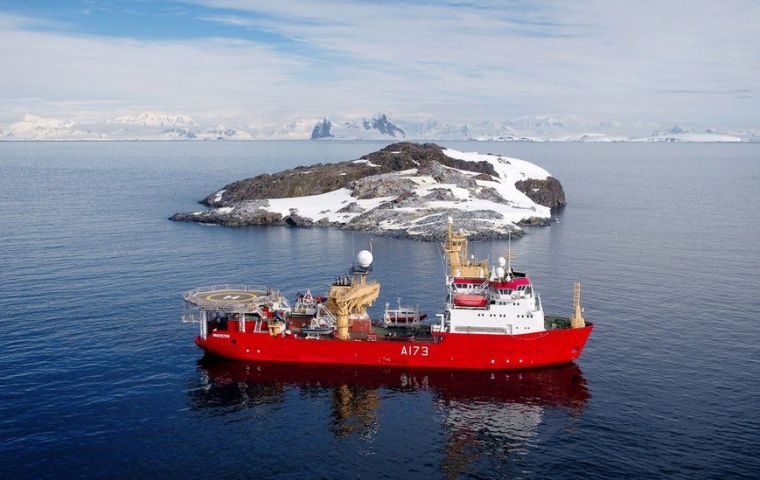MercoPress. South Atlantic News Agency
HMS Protector officer visits “his island” in Antarctica
 The Pitt Islands are uninhabited – except for the region's wildlife (Picture: Royal Navy).
The Pitt Islands are uninhabited – except for the region's wildlife (Picture: Royal Navy). No man is an island – apart from Royal Navy officer Lieutenant Commander Dave Pitt. Currently deployed on survey ship HMS Protector, Lt Cdr Pitt has become possibly the first Pitt to set foot on the Pitt Islands.
Located 8,500 miles from the UK, 675 miles south of Cape Horn and 950 miles from the Falkland Islands, Lt Cdr Pitt and his shipmates seized the opportunity to spend the night in the Pitt Islands.
Scattered across an area of Antarctic Ocean, the islands are about twice the size of Norwich and were discovered barely 200 years ago by a British expedition.
While HMS Protector, conducting her second patrol of Antarctic waters this year, surveyed waters, a 12-strong party landed on Pitt Island to study its gentoo penguin population.
This included three Royal Marines as cold weather survival specialists, Lt Cdr Pitt, Protector's commanding officer, Captain Michael Wood and seven shipmates.
After setting up camp, the team dined on Navy ration packs as the sun went down and temperatures plunged.
Lt Cdr Pitt said winds picked up overnight “along with the sounds of the buffering tents, nesting penguins and half a dozen fur seals”.
“The surrounding noises were drowned out by snoring sailors and marines resting from an amazing day prior to embarking back in Protector,” he said.
“I cannot believe how privileged I am to be able to camp overnight in the Antarctic, on a group of islands with which I share a name, named in honor of a former British Prime Minister,” Lt Cdr Pitt added.
Collectively, the chain take its name from the former Prime Minister William Pitt, but the individual islands are named after characters in Dickens' Pickwick Papers.
Temperatures on the islands climb just above freezing even in high summer, when there's still snow on the ground and the wind chill takes it down to well below zero, and the craggy archipelago is uninhabited – except for the region's wildlife.
HMS Protector is currently on her second trip around the Antarctic, helping to protect and conserve the region's wildlife, preserve historic sites, manage tourism and gather climate data.
The ship is also updating Admiralty charts having surveyed more than 400 sq km of waters surrounding the Antarctic Peninsula.
On her second stint around the Antarctic peninsula this austral summer, Plymouth-based HMS Protector has paid a succession of goodwill visits to research stations, including Brown (Argentine), Videla (Chilean) and Vernadsky (Ukrainian) – upholding the Antarctic Treaty which the nation signed on December first 1959.
Under that international agreement, Britain is duty-bound to protect and conserve the region’s unique wildlife, preserve historic sites, manage tourism, work with scientists of all nationalities and gather data about the weather and climate.
The ship is also updating Admiralty charts – used by merchant seafarers as well as the Royal Navy – having surveyed more than 400 square kilometers of waters surrounding the Antarctic Peninsula (that’s an area the size of the Isle of Wight) in the past month alone.
“With the steady growth in cruise ship activity, we have collected data that will contribute directly to their safety,” explained Captain Michael Wood, HMS Protector’s Commanding Officer.
“Surveying alone provides many obstacles, but doing it in Antarctica when surrounded by ice is the Premier League of hydrographic operations.
“The challenges range from dangerous ice conditions, blizzards, freezing waters and the constant toll of sustaining people and equipment in this frozen environment.”




Top Comments
Disclaimer & comment rulesCommenting for this story is now closed.
If you have a Facebook account, become a fan and comment on our Facebook Page!